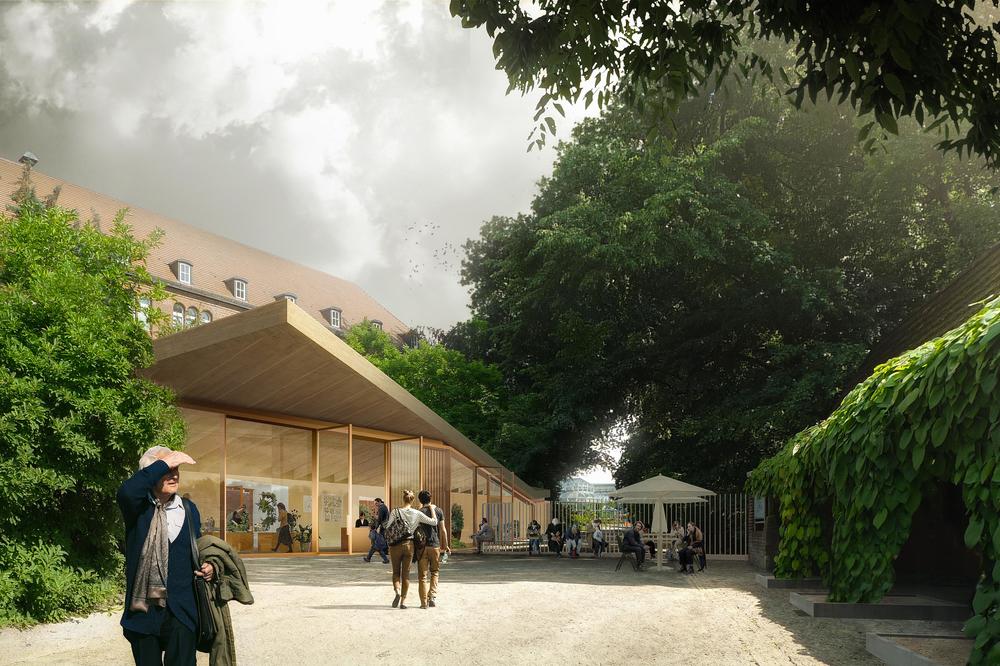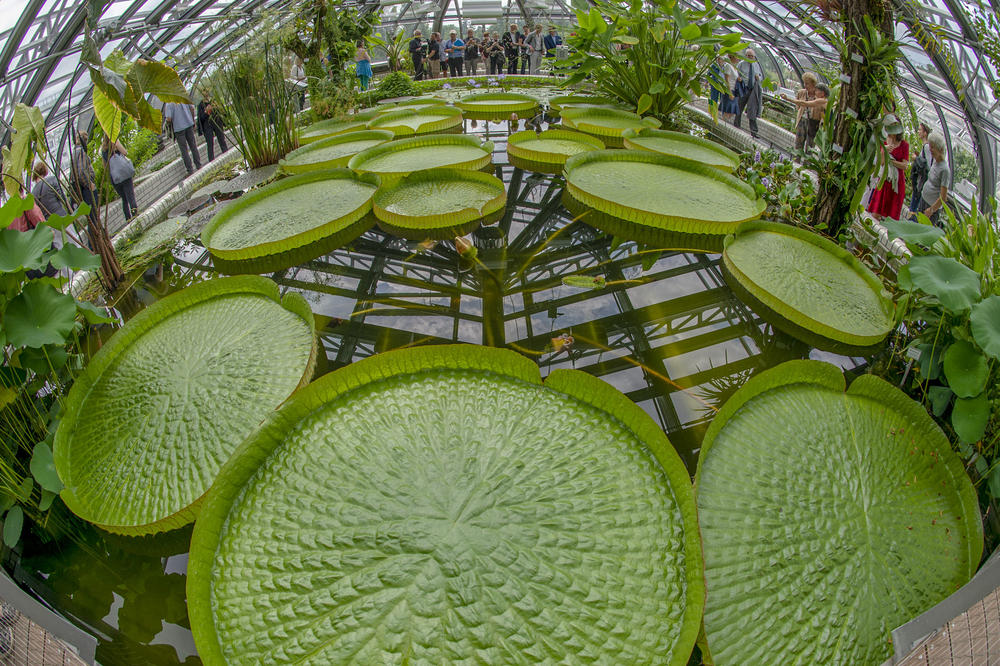“The World in a Garden”
The Botanic Garden in Dahlem is undergoing renovations to accommodate visitors. Remodeling and construction set for completion in 2022.
Aug 08, 2019
Informative and inviting. Plans for the new visitor center at the Königin-Luise-Platz entrance.
Image Credit: Simulation/Fotos: ® Luxigon
The windows in the Mediterranean House are open. The air smells of rosemary, sage, and Italian strawflower – a Mediterranean mixed forest in early summer. The precise origin of the fragrant breeze is hard to identify. Is it coming from the Canary Islands? Or from Spain, which seems to be just a few steps away? Maybe Greece is right behind the next bend in the path.
“The world in a garden” has been the guiding principle behind the Botanic Gardens in Dahlem in southwest Berlin for the last one hundred years. As you leave the world of Mediterranean vegetation, North American pines sway in the wind a stone’s throw away. If you continue down the path, you pass through Central Asia and China. The entire northern hemisphere – or at least its flora – is spread out across one and a half kilometers, waiting for visitors to explore with all of their senses.
Over the years, however, the signs, the information display panels, even the paths themselves have been worn down, so the entire infrastructure is now being renovated for visitors. The project was made possible by a funding program aimed at improving regional economic structure that was approved in 2015 and 2018. The program’s German name is “Gemeinschaftsaufgabe Verbesserung der regionalen Wirtschaftsstruktur.” The funds will be used to build a new visitor center at the main entrance, renovate the ponds and waterways, improve pathways, and install new information panels for visitors.
For Professor Thomas Borsch, director of the Botanic Garden and the adjoining Botanical Museum, these are efforts in a more extensive project: They are part of a master plan to ensure that for generations to come the Botanic Garden can continue to fulfill its mission of making plant diversity engaging for a broad audience while at the same time educating people about it.
“A Masterpiece of Gardening”
The Botanic Garden is one of Freie Universität’s central facilities and holds the second largest collection of living plants in the world, surpassed only by the Royal Botanic Gardens in Kew, London. Berlin’s “Capital Garden,” as Borsch calls it, has over 20,000 species of plants. The Botanic Garden is not so much a park as it is a “masterpiece of gardening” on 43 hectares of land, where every plant has been scientifically documented and each square meter carefully designed.
The collection of living plants is complemented by the herbarium with its more than 3.8 million plant specimens. It not only safely preserves the botanical treasures collected by Alexander von Humboldt during his America expedition, but also continues to expand with around 40,000 new objects every year. The DNA bank also acquires new specimens regularly. Kept at −80° C, it contains the genetic material of thousands of plant species. The Dahlem Seed Bank also continues to grow as the largest gene bank for wild plants in Germany.
Thomas Borsch does not have to worry about a lack of interest in the garden’s treasures. On the contrary, he says, the threat of extinction and loss of biodiversity have always been central issues for the Botanic Garden and Botanical Museum. “Society has become more aware of how important biological diversity is,” Borsch says. Part of the Botanic Garden’s mission is to sensitize people to environmental topics and educate them on ways to preserve biodiversity sustainably, he explains. The garden has seen a rise in visitors over the years with 450,000 in 2018 alone. It is becoming a real magnet for southwest Berlin, according to Borsch.
Tourist magnet: Every year the giant water lily Victoria attracts plant lovers from around the world.
Image Credit: Bernd Wannenmacher
The expansive tract of land was originally part of a Prussian plan to build a kind of “campus of knowledge” in Dahlem at the beginning of the twentieth century. Thanks to the diversity of plant life found here, it is also home to a great number of insects.
But how can this knowledge about plant diversity, nature, and human influence best be conveyed to local and international visitors? The question is one of the motivating factors behind the project to redesign the infrastructure fundamentally. The site was established a hundred years ago to model the habitats of plants in the northern hemisphere, and after renovations its botanical-geographic purpose will be put clearly on display for the first time. New visitor information will tell all about the numerous plants and their unique histories. The entire wayfinding system that helps visitors orient themselves is also going to be redone.
A new area dedicated to harvestable plants gives the Botanic Garden the opportunity to engage more actively with current social issues like sustainability and food production or urban gardening.
Finally, they plan to build a visitor center at the Königin-Luise-Platz entrance and make improvements to the ponds in the arboretum. During the vast renovation and improvement project, the Vattenfall power company will be replacing the heating pipelines that run beneath the garden’s main pathway. The pipelines will be taken out and replaced in three segments during the warm months, when heating is shut off. The parallel construction projects will help avoid having to tear up the pathways twice.
The total funding for the program to improve the regional economic structure includes 14 million euros for new landscaping of the outdoor areas, and 7.5 million euros for the Botanical Museum, which will help support the reconceptualization of its permanent collection display and special exhibit areas, all starting in autumn 2019.
Director Thomas Borsch currently estimates that they will be finished by spring 2022. Even though it looks like a construction site when you approach the entrance, the Botanic Garden will remain open for visitors during renovations. A favorite among visitors, the giant Amazon water lily (Victoria amazonica) – which is currently in bloom – in the newly reopened Victoria House will also remain accessible. On June 15 for the Long Night of Science, the Botanical Museum will devote the evening to Alexander von Humboldt’s plants.
This text originally appeared in German on June 8, 2019, in the Tagesspiegel newspaper supplement published by Freie Universität.


